





Most people seem to have an innate fear and loathing of snakes, which sometimes works out for the snakes (people leave them alone) and sometimes it doesn't (people kill them when they find them in their gardens). There is no way I can convince someone who is terrified of snakes not to be, but perhaps a discussion of their benefits and harmlessness to the garden will deter a few would-be killers of these wonderful and efficient garden predators.
Snakes are members of the reptile family, which also includes lizards, turtles, alligators and a few other odds and ends. They are also somewhat closely related to amphibians. These are poikilotherms, or cold-blooded vertebrates, meaning that they have no way of controlling their body temperature other than via the environment they live in. This is why one often sees a snake doing nothing but lying in a path or one a rock on a sunny day. They are trying to warm themselves up to function properly, digest or simply feel better.
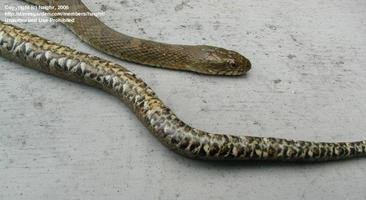
This sad harmless water snake may have been killed out of fear and misunderstanding, as it is a great garden predator and only can benefit the garden
By the benefit of their leglessness they are able to move about quietly, disturbing very little of the environment, getting into the smallest holes and areas where their prey may be hiding, and are able to sneak up on them without being noticed. It is this lack of legs and the unnerving way they propel themselves through their environment that bothers so many people. They always look like they’re moving faster than they really are.
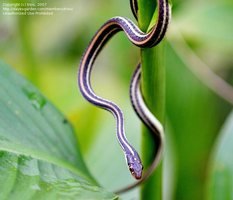
Snakes are very agile and can climb plants despite no legs, as this snake is doing on this Canna, looking for insects (photo by trois)
In the garden snakes can be of great benefit. They eat insects or rodents primarily, neither which are likely to benefit the garden themselves. One rodent-eating snake can nearly decimate a rat family in weeks, and several small snakes can do severe damage to a grasshopper population in a confined area in just one summer.
And they do this handiwork without damaging the environment one bit. They don’t dig holes (just use holes already dug by rodents or other burrowers). They don’t chew or damage the landscape in any way (wish I could say that about our neighborhood squirrels). No plants are harmed by snakes in any way, either from being eaten or from their physical presence moving through them. They don’t contribute one bit to noise pollution. They leave very little in the way of droppings (excellent fertilizer since their prey is so well digested). And they avoid the gardener at all costs. They are non-aggressive creatures- they do NOT ever attack people (at least no snakes in the US) and will never bite unless stepped on, picked up or forced into a corner or threatened with imminent injury. Even then, all snakes would much rather get away than risk a fight.
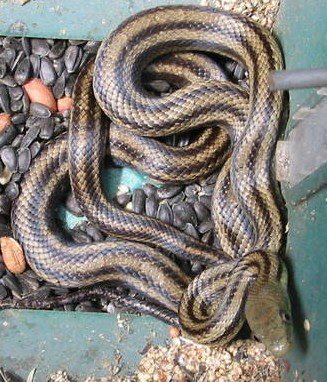 Rat snake waiting for rodens in the barn
Rat snake waiting for rodens in the barn
Most snakes in the US are nonpoisonous and are relatively harmless. They are very clean animals and have few diseases they can transmit to people (rare cases of Salmonella occur from handling and then not washing hands)- they don’t carry rabies, fleas, mange, or skin funguses. A snake is far less likely to bite someone even if picked up than just about any other wild animal one could handle. Ever pick up a wild raccoon, or squirrel, or hawk? Talk about dangerous! And even if a snake is forced into biting, their bites are far less worrisome (save for the poisonous species) than from something as common as a cat. I have been to the hospital multiple times for cat bites, but not once for a snake bite (and my job includes handling a lot of both). Far more people have lost hands or become seriously ill from cat bites than from snake bites in the US. Rattlesnakes and other pit vipers are very poisonous animals and should be avoided of course. But many more people die of bee stings yearly in the US than of rattlesnake bites. In fact, death from a rattlesnake bite is a rarity. Still, these are snakes that would probably be best ushered out of the garden for both you and your pet’s sakes.
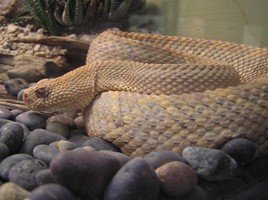 rattlesnake in zoo, not garden
rattlesnake in zoo, not garden
By far the most common snakes encountered in most US gardens is the common Garter Snake (often mistakenly called a Gardener Snake) and related snakes such as green snakes, ribbon snakes, water snakes etc.. These snakes and all their close relatives feed nearly exclusively on insects, though some larger ones will eat small vertebrates (mice, frogs etc.). These are highly beneficial animals and are reclusive, shy creatures. There is no reason to fear these snakes, and the benefit they can do for a garden is worth having them around.
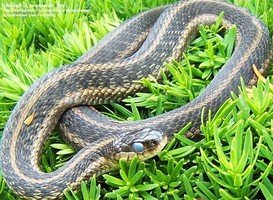
Garter snake sunning on the grass. The blue over the eyes indicate it's about to shed its skin. Photo by Andy P
Another group of common and beneficial snakes for the garden are the constrictors. Here in the US these are limited to small boas and non-boid larger snakes like King Snakes, Gopher Snakes, Racers and Rat Snakes. These animals live primarily on rodents and who doesn’t want rats and gophers removed from their gardens? These snakes are equally as harmless and non-aggressive as are Garter Snakes, and a garden sighting should be a blessed event.
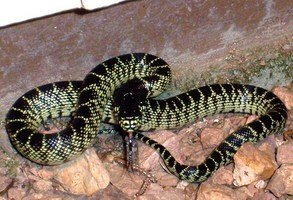
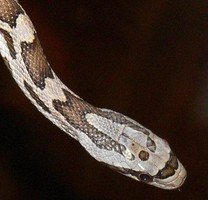
Kings snake on left, and rat snake on right, both great rodent hunters... and king snakes also feed on rattlesnakes. photo on left by kakiana, and right by trois
But even the poisonous snakes have their effect on wild rodent populations and should not be maligned just because they are poisonous. Without these snakes we would overrun with rats and gophers. But I do think these snakes are better left in the wild than in the garden.
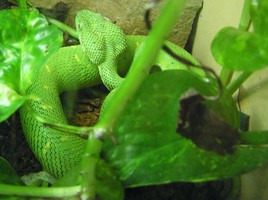
Pretty but dangerous. This viper is an efficient roden eater, but a potential danger to pets and people, so this is one best not to have in the garden... fortunately this is an Asian snake and never encountered in US gardens.
For some reason far less people are bothered by lizards than snakes, yet the two are very closely related. Both are great garden predators and help keep the pests at bay. If one just thinks of snakes as lizards that just don’t have their legs, it might help to make them seem less scary. But either way, you have to respect their benefit to the garden.
Copyright © www.100flowers.win Botanic Garden All Rights Reserved